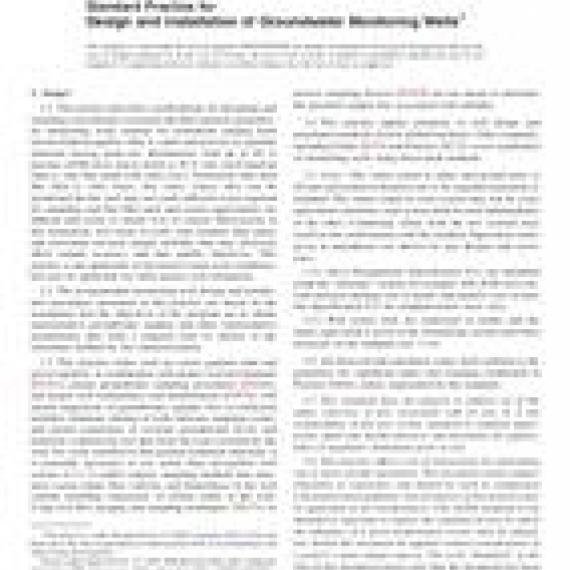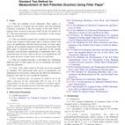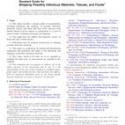ASTM D5092/D5092M-16
ASTM D5092/D5092M-16 Standard Practice for Design and Installation of Groundwater Monitoring Wells
standard by ASTM International, 11/15/2016
Full Description
1.1This practice describes a methodology for designing and installing conventional (screened and filter-packed) groundwater monitoring wells suitable for formations ranging from unconsolidated aquifers (that is, sands and gravels) to granular materials having grain-size distributions with up to 50 % passing a #200 sieve and as much as 20 % clay-sized material (that is, silty fine sands with some clay). Formations finer than this (that is, silts, clays, silty clays, clayey silts) can be monitored but the well may not yield sufficient water required for sampling, and fine filter pack and screen requirements are difficult and costly to install. Use of coarser filter/screens in fine formations will result in wells with unstable filter packs and associated elevated sample turbidity that may adversely affect sample accuracy and data quality objectives. This practice is not applicable in fractured or karst rock conditions, but may be applicable for other porous rock formations.
1.2The recommended monitoring well design and installation procedures presented in this practice are based on the assumption that the objectives of the program are to obtain representative groundwater samples and other representative groundwater data from a targeted zone of interest in the subsurface defined by site characterization.
1.3This practice when used on coarse grained sand and gravel aquifers, in combination with proper well development (D5521), proper groundwater sampling procedures (D4448), and proper well maintenance and rehabilitation (D5978), will permit acquisition of groundwater samples free of artifactual turbidity, eliminate siltation of wells between sampling events, and permit acquisition of accurate groundwater levels and hydraulic conductivity test data from the zone screened by the well. For wells installed in fine-grained formation materials, it is generally necessary to use much finer pre-packed well screens (6.3.3.2) and/or employ sampling methods that minimize screen intake flow velocity, and disturbance of the well column including suspension of settled solids in the well. Using low-flow purging and sampling techniques (D6771) or passive sampling devices (D7929) are two means to minimize the potential sample bias associated with turbidity.
1.4This practice applies primarily to well design and installation methods used in drilled boreholes. Other standards, including Guide D6724 and Practice D6725, cover installation of monitoring wells using direct-push methods.
1.5Units-The values stated in either inch-pound units or SI units [presented in brackets] are to be regarded separately as standard. The values stated in each system may not be exact equivalents; therefore, each system shall be used independently of the other. Combining values from the two systems may result in non-conformance with the standard. Equivalent values given in parentheses are shown for mix designs and sieves sizes.
1.5.1Sieve Designations (Specification E11) are identified using the alternate system, for example, #40, #200 sieve etc. with nominal opening size in inches and particle sizes in mm. See Specification E11 for standard metric sieve sizes.
1.5.2Well screen slots are expressed in inches and the metric equivalent is given in the terminology section and when necessary in the standard (see 3.3.6).
1.6All observed and calculated values shall conform to the guidelines for significant digits and rounding established in Practice D6026, unless superseded by this standard.
1.7This standard does not purport to address all of the safety concerns, if any, associated with its use. It is the responsibility of the user of this standard to establish appropriate safety and health practices and determine the applicability of regulatory limitations prior to use.
1.8This practice offers a set of instructions for performing one or more specific operations. This document cannot replace education or experience and should be used in conjunction with professional judgment. Nat all aspects of this practice may be applicable in all circumstances. This ASTM standard is not intended to represent or replace the standard of care by which the adequacy of a given professional service must be judged, nor should this document be applied without consideration of a project's many unique aspects. The word Standard in the title of this document means only that the document has been approved through the ASTM consensus process.


































